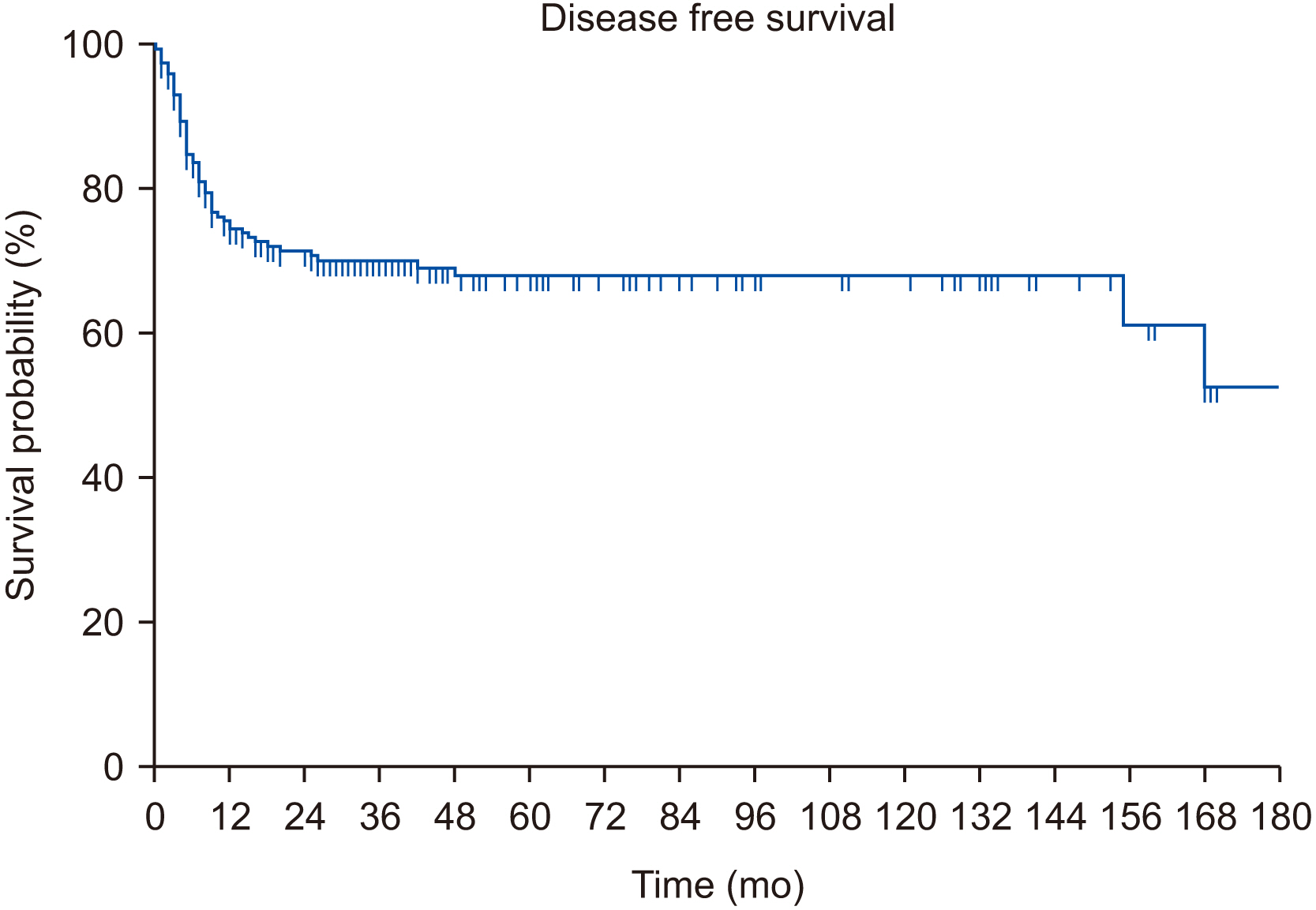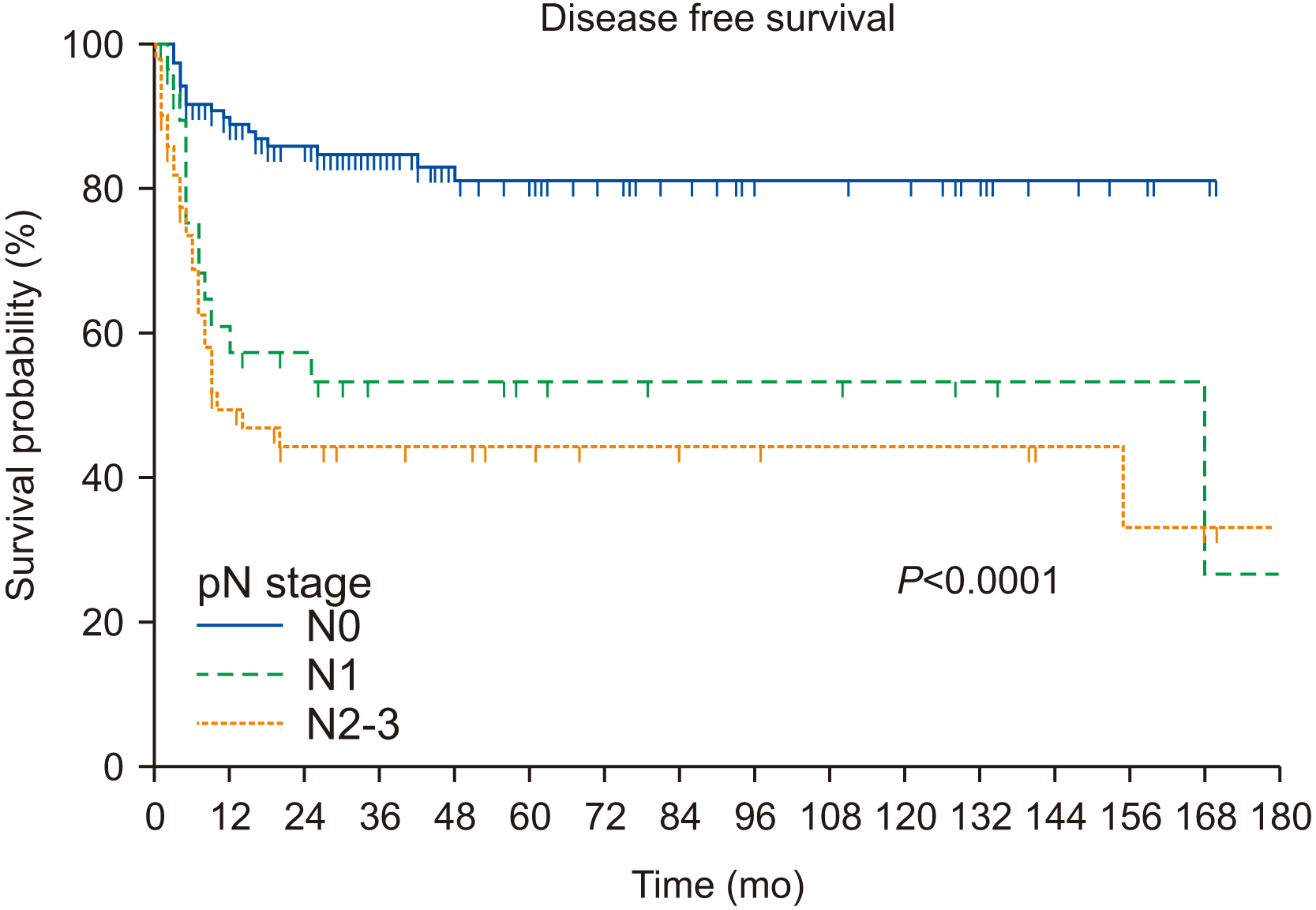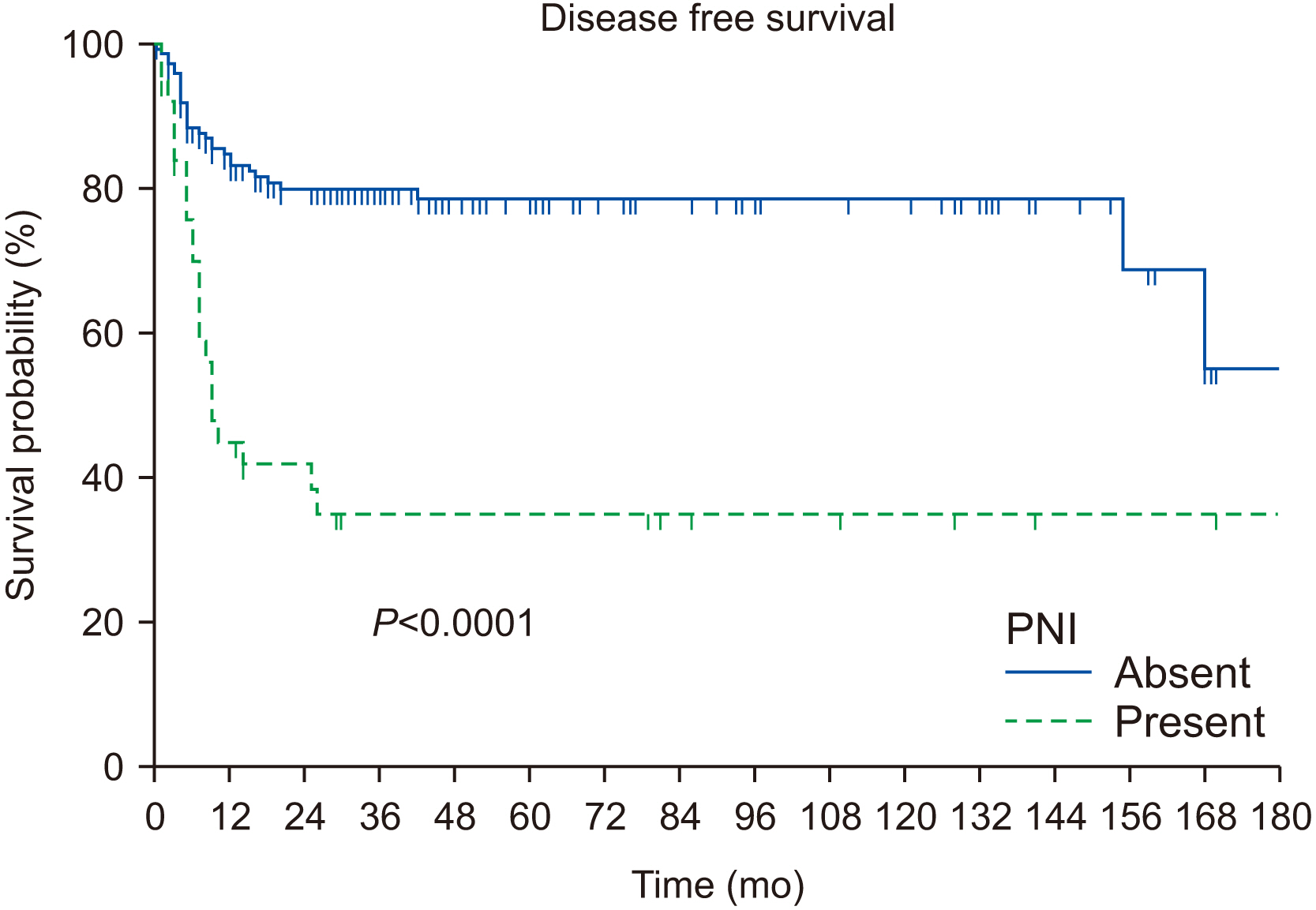J Korean Assoc Oral Maxillofac Surg.
2022 Aug;48(4):192-200. 10.5125/jkaoms.2022.48.4.192.
Treatment outcomes and prognostic factors in oral tongue cancer: a 20-year retrospective study at the National Cancer Center, South Korea
- Affiliations
-
- 1Oral Oncology Clinic, Research Institute and Hospital, National Cancer Center, Goyang, Korea
- 2Department of Oral and Maxillofacial Surgery, Seoul National University Dental Hospital, Seoul, Korea
- 3Oral Cancer Center, Seoul National University Dental Hospital, Seoul, Korea
- KMID: 2532816
- DOI: http://doi.org/10.5125/jkaoms.2022.48.4.192
Abstract
Objectives
This study aimed to analyze the treatment outcomes and to evaluate the clinicopathological prognostic factors of oral tongue cancer.
Patients and Methods
We retrospectively analyzed treatment results and prognostic factors in 205 patients with oral tongue squamous cell carcinoma who were admitted to the National Cancer Center, South Korea, between January 2001 and December 2020. The patients were treated with surgery and postoperative, definitive radiotherapy (RT) or chemoradiotherapy (CRT).
Results
Eighteen patients (8.8%) were treated with curative RT or CRT, while the rest (91.2%) were treated with surgery with or without postoperative RT or CRT. The median follow-up period was 30 months (range, 0-234 months). The 5-year overall survival (OS) and 5-year disease-free survival (DFS) were 72% and 63%, respectively. Multivariate analysis revealed that a positive neck nodal status (N1, N2-3) was significantly associated with poorer 5-year OS and DFS, while perineural invasion was associated with poorer 5-year DFS.
Conclusion
Cervical metastasis and perineural invasion are significant prognostic predictors, and combination treatments are necessary for improving OS and DFS in patients with these factors.
Keyword
Figure
Reference
-
References
1. Bray F, Ferlay J, Soerjomataram I, Siegel RL, Torre LA, Jemal A. 2018; Global cancer statistics 2018: GLOBOCAN estimates of incidence and mortality worldwide for 36 cancers in 185 countries. CA Cancer J Clin. 68:394–424. https://doi.org/10.3322/caac.21492. DOI: 10.3322/caac.21492. PMID: 30207593.
Article2. Shah JP, Gil Z. 2009; Current concepts in management of oral cancer--surgery. Oral Oncol. 45:394–401. https://doi.org/10.1016/j.oraloncology.2008.05.017. DOI: 10.1016/j.oraloncology.2008.05.017. PMID: 18674952. PMCID: PMC4130348.
Article3. Pulte D, Brenner H. 2010; Changes in survival in head and neck cancers in the late 20th and early 21st century: a period analysis. Oncologist. 15:994–1001. https://doi.org/10.1634/theoncologist.2009-0289. DOI: 10.1634/theoncologist.2009-0289. PMID: 20798198. PMCID: PMC3228039.
Article4. Zanoni DK, Montero PH, Migliacci JC, Shah JP, Wong RJ, Ganly I, et al. 2019; Survival outcomes after treatment of cancer of the oral cavity (1985-2015). Oral Oncol. 90:115–21. https://doi.org/10.1016/j.oraloncology.2019.02.001. DOI: 10.1016/j.oraloncology.2019.02.001. PMID: 30846169. PMCID: PMC6417804.
Article5. Choi SW, Moon EK, Park JY, Jung KW, Oh CM, Kong HJ, et al. 2014; Trends in the incidence of and survival rates for oral cavity cancer in the Korean population. Oral Dis. 20:773–9. https://doi.org/10.1111/odi.12251. DOI: 10.1111/odi.12251. PMID: 24735459.
Article6. Bello IO, Soini Y, Salo T. 2010; Prognostic evaluation of oral tongue cancer: means, markers and perspectives (II). Oral Oncol. 46:636–43. https://doi.org/10.1016/j.oraloncology.2010.06.008. DOI: 10.1016/j.oraloncology.2010.06.008. PMID: 20637679.
Article7. van Dijk BA, Brands MT, Geurts SM, Merkx MA, Roodenburg JL. 2016; Trends in oral cavity cancer incidence, mortality, survival and treatment in the Netherlands. Int J Cancer. 139:574–83. https://doi.org/10.1002/ijc.30107. DOI: 10.1002/ijc.30107. PMID: 27038013.
Article8. Faisal M, Dhanani R, Ullah S, Bakar MA, Irfan N, Malik KI, et al. 2021; Prognostic outcomes of treatment naïve oral tongue squamous cell carcinoma (OTSCC): a comprehensive analysis of 14 years. Eur Arch Otorhinolaryngol. 278:3045–53. https://doi.org/10.1007/s00405-020-06482-x. DOI: 10.1007/s00405-020-06482-x. PMID: 33236214.
Article9. Marra A, Violati M, Broggio F, Codecà C, Blasi M, Luciani A, et al. 2019; Long-term disease-free survival in surgically-resected oral tongue cancer: a 10-year retrospective study. Acta Otorhinolaryngol Ital. 39:84–91. https://doi.org/10.14639/0392-100X-2336. DOI: 10.14639/0392-100X-2336. PMID: 31097825. PMCID: PMC6522864.
Article10. Han G, Xu C, Yu D. 2018; Mechanisms correlated with chemotherapy resistance in tongue cancers. J Cancer Res Ther. 14:1–5. https://doi.org/10.4103/jcrt.JCRT_763_17. DOI: 10.4103/jcrt.JCRT_763_17. PMID: 29516950.
Article11. Rusthoven K, Ballonoff A, Raben D, Chen C. 2008; Poor prognosis in patients with stage I and II oral tongue squamous cell carcinoma. Cancer. 112:345–51. https://doi.org/10.1002/cncr.23183. DOI: 10.1002/cncr.23183. PMID: 18041071.
Article12. Cheng YJ, Tsai MH, Chiang CJ, Tsai ST, Liu TW, Lou PJ, et al. 2018; Adjuvant radiotherapy after curative surgery for oral cavity squamous cell carcinoma and treatment effect of timing and duration on outcome - a Taiwan Cancer Registry national database analysis. Cancer Med. 7:3073–83. https://doi.org/10.1002/cam4.1611. DOI: 10.1002/cam4.1611. PMID: 29905028. PMCID: PMC6051157.
Article13. Asakage T, Yokose T, Mukai K, Tsugane S, Tsubono Y, Asai M, et al. 1998; Tumor thickness predicts cervical metastasis in patients with stage I/II carcinoma of the tongue. Cancer. 82:1443–8. https://doi.org/10.1002/(sici)1097-0142(19980415)82:8<1443::aid-cncr2>3.0.co;2-a. DOI: 10.1002/(SICI)1097-0142(19980415)82:8<1443::AID-CNCR2>3.0.CO;2-A. PMID: 9554518.
Article14. Po Wing Yuen A, Lam KY, Lam LK, Ho CM, Wong A, Chow TL, et al. 2002; Prognostic factors of clinically stage I and II oral tongue carcinoma - a comparative study of stage, thickness, shape, growth pattern, invasive front malignancy grading, Martinez-Gimeno score, and pathologic features. Head Neck. 24:513–20. https://doi.org/10.1002/hed.10094. DOI: 10.1002/hed.10094. PMID: 12112547.
Article15. Huang SH, Hwang D, Lockwood G, Goldstein DP. OʼSullivan B. 2009; Predictive value of tumor thickness for cervical lymph-node involvement in squamous cell carcinoma of the oral cavity: a meta-analysis of reported studies. Cancer. 115:1489–97. https://doi.org/10.1002/cncr.24161. DOI: 10.1002/cncr.24161. PMID: 19197973.
Article16. Inoue M, Nagata C, Tsuji I, Sugawara Y, Wakai K, Tamakoshi A, et al. 2012; ; Research Group for the Development and Evaluation of Cancer Prevention Strategies in Japan. Impact of alcohol intake on total mortality and mortality from major causes in Japan: a pooled analysis of six large-scale cohort studies. J Epidemiol Community Health. 66:448–56. https://doi.org/10.1136/jech.2010.121830. DOI: 10.1136/jech.2010.121830. PMID: 21148820.
Article17. Faisal M, Abu Bakar M, Sarwar A, Adeel M, Batool F, Malik KI, et al. 2018; Depth of invasion (DOI) as a predictor of cervical nodal metastasis and local recurrence in early stage squamous cell carcinoma of oral tongue (ESSCOT). PLoS One. 13:e0202632. https://doi.org/10.1371/journal.pone.0202632. DOI: 10.1371/journal.pone.0202632. PMID: 30133515. PMCID: PMC6105019.
Article18. Montoro JRMC, Hicz HA, de Souza L, Livingstone D, Melo DH, Tiveron RC, et al. 2008; Prognostic factors in squamous cell carcinoma of the oral cavity. Braz J Otorhinolaryngol. 74:861–6. https://doi.org/10.1016/S1808-8694(15)30146-4. DOI: 10.1016/S1808-8694(15)30146-4. PMID: 19582342.
Article19. Dolens EDS, Dourado MR, Almangush A, Salo TA, Gurgel Rocha CA, da Silva SD, et al. 2021; The impact of histopathological features on the prognosis of oral squamous cell carcinoma: a comprehensive review and meta-analysis. Front Oncol. 11:784924. https://doi.org/10.3389/fonc.2021.784924. DOI: 10.3389/fonc.2021.784924. PMID: 34858861. PMCID: PMC8631280.
Article20. Sharma K, Ahlawat P, Gairola M, Tandon S, Sachdeva N, Sharief MI. 2019; Prognostic factors, failure patterns and survival analysis in patients with resectable oral squamous cell carcinoma of the tongue. Radiat Oncol J. 37:73–81. https://doi.org/10.3857/roj.2018.00577. DOI: 10.3857/roj.2018.00577. PMID: 31266288. PMCID: PMC6610009.
Article21. Thiagarajan S, Nair S, Nair D, Chaturvedi P, Kane SV, Agarwal JP, et al. 2014; Predictors of prognosis for squamous cell carcinoma of oral tongue. J Surg Oncol. 109:639–44. https://doi.org/10.1002/jso.23583. DOI: 10.1002/jso.23583. PMID: 24619660.
Article22. Fagan JJ, Collins B, Barnes L, DʼAmico F, Myers EN, Johnson JT. 1998; Perineural invasion in squamous cell carcinoma of the head and neck. Arch Otolaryngol Head Neck Surg. 124:637–40. https://doi.org/10.1001/archotol.124.6.637. DOI: 10.1001/archotol.124.6.637. PMID: 9639472.
Article23. Hilly O, Shkedy Y, Hod R, Soudry E, Mizrachi A, Hamzany Y, et al. 2013; Carcinoma of the oral tongue in patients younger than 30 years: comparison with patients older than 60 years. Oral Oncol. 49:987–90. https://doi.org/10.1016/j.oraloncology.2013.07.005. DOI: 10.1016/j.oraloncology.2013.07.005. PMID: 23927849.
Article24. Zhang YY, Wang DC, Su JZ, Jia LF, Peng X, Yu GY. 2017; Clinicopathological characteristics and outcomes of squamous cell carcinoma of the tongue in different age groups. Head Neck. 39:2276–82. https://doi.org/10.1002/hed.24898. DOI: 10.1002/hed.24898. PMID: 28842932.
Article25. Jeon JH, Kim MG, Park JY, Lee JH, Kim MJ, Myoung H, et al. 2017; Analysis of the outcome of young age tongue squamous cell carcinoma. Maxillofac Plast Reconstr Surg. 39:41. https://doi.org/10.1186/s40902-017-0139-8. DOI: 10.1186/s40902-017-0139-8. PMID: 29302590. PMCID: PMC5742317.
Article26. Cadoni G, Giraldi L, Petrelli L, Pandolfini M, Giuliani M, Paludetti G, et al. 2017; Prognostic factors in head and neck cancer: a 10-year retrospective analysis in a single-institution in Italy. Acta Otorhinolaryngol Ital. 37:458–66. https://doi.org/10.14639/0392-100X-1246. DOI: 10.14639/0392-100X-1246. PMID: 28663597. PMCID: PMC5782422.
Article27. Molteni G, Valerini S, Alicandri-Ciufelli M, Sprio AE, Crosetti E, Berta GN, et al. 2018; Unravelling the risk factors that underlie oral and oropharyngeal surgery in elderly. Acta Otorhinolaryngol Ital. 38:409–16. https://doi.org/10.14639/0392-100X-1507. DOI: 10.14639/0392-100X-1507. PMID: 29393927. PMCID: PMC6265672.
Article28. Listl S, Jansen L, Stenzinger A, Freier K, Emrich K, Holleczek B, et al. 2013; ; GEKID Cancer Survival Working Group. Survival of patients with oral cavity cancer in Germany. PLoS One. 8:e53415. https://doi.org/10.1371/journal.pone.0053415. DOI: 10.1371/journal.pone.0053415. PMID: 23349710. PMCID: PMC3548847.
Article29. Funk GF, Karnell LH, Robinson RA, Zhen WK, Trask DK, Hoffman HT. 2002; Presentation, treatment, and outcome of oral cavity cancer: a National Cancer Data Base report. Head Neck. 24:165–80. https://doi.org/10.1002/hed.10004. DOI: 10.1002/hed.10004. PMID: 11891947.
Article30. Garavello W, Spreafico R, Somigliana E, Gaini L, Pignataro L, Gaini RM. 2008; Prognostic influence of gender in patients with oral tongue cancer. Otolaryngol Head Neck Surg. 138:768–71. https://doi.org/10.1016/j.otohns.2008.02.026. DOI: 10.1016/j.otohns.2008.02.026. PMID: 18503852.
Article31. Leoncini E, Vukovic V, Cadoni G, Pastorino R, Arzani D, Bosetti C, et al. 2015; Clinical features and prognostic factors in patients with head and neck cancer: results from a multicentric study. Cancer Epidemiol. 39:367–74. https://doi.org/10.1016/j.canep.2015.02.004. DOI: 10.1016/j.canep.2015.02.004. PMID: 25770642.
Article32. Li Y, Mao Y, Zhang Y, Cai S, Chen G, Ding Y, et al. 2014; Alcohol drinking and upper aerodigestive tract cancer mortality: a systematic review and meta-analysis. Oral Oncol. 50:269–75. https://doi.org/10.1016/j.oraloncology.2013.12.015. DOI: 10.1016/j.oraloncology.2013.12.015. PMID: 24405883.
Article33. Koo K, Barrowman R, McCullough M, Iseli T, Wiesenfeld D. 2013; Non-smoking non-drinking elderly females: a clinically distinct subgroup of oral squamous cell carcinoma patients. Int J Oral Maxillofac Surg. 42:929–33. https://doi.org/10.1016/j.ijom.2013.04.010. DOI: 10.1016/j.ijom.2013.04.010. PMID: 23702369.
Article34. Loeffelbein D, Ritschl LM, Güll FD, Roth M, Wolff KD, Mücke T. 2017; Influence of possible predictor variables on the outcome of primary oral squamous cell carcinoma: a retrospective study of 392 consecutive cases at a single centre. Int J Oral Maxillofac Surg. 46:413–21. https://doi.org/10.1016/j.ijom.2016.11.014. DOI: 10.1016/j.ijom.2016.11.014. PMID: 28007325.
Article35. Sparano A, Weinstein G, Chalian A, Yodul M, Weber R. 2004; Multivariate predictors of occult neck metastasis in early oral tongue cancer. Otolaryngol Head Neck Surg. 131:472–6. https://doi.org/10.1016/j.otohns.2004.04.008. DOI: 10.1016/j.otohns.2004.04.008. PMID: 15467620.
Article36. Jones HB, Sykes A, Bayman N, Sloan P, Swindell R, Patel M, et al. 2009; The impact of lymphovascular invasion on survival in oral carcinoma. Oral Oncol. 45:10–5. https://doi.org/10.1016/j.oraloncology.2008.03.009. DOI: 10.1016/j.oraloncology.2008.03.009. PMID: 18620889.
Article37. Shim SJ, Cha J, Koom WS, Kim GE, Lee CG, Choi EC, et al. 2010; Clinical outcomes for T1-2N0-1 oral tongue cancer patients underwent surgery with and without postoperative radiotherapy. Radiat Oncol. 5:43. https://doi.org/10.1186/1748-717X-5-43. DOI: 10.1186/1748-717X-5-43. PMID: 20504371. PMCID: PMC2887888.
Article38. Grégoire V, Lefebvre JL, Licitra L. Felip E; EHNS-ESMO-ESTRO Guidelines Working Group. 2010; Squamous cell carcinoma of the head and neck: EHNS-ESMO-ESTRO clinical practice guidelines for diagnosis, treatment and follow-up. Ann Oncol. 21 Suppl 5:v184–6. https://doi.org/10.1093/annonc/mdq185. DOI: 10.1093/annonc/mdq185. PMID: 20555077.
Article
- Full Text Links
- Actions
-
Cited
- CITED
-
- Close
- Share
- Similar articles
-
- Dysphagia in Tongue Cancer Patients
- Clinical Outcome of the Squamous Cell Carcinoma of Tongue: Experience of National Cancer Center
- Prognostic factors, failure patterns and survival analysis in patients with resectable oral squamous cell carcinoma of the tongue
- Complete denture rehabilitation of partially glossectomized patient using palatal augmentation prosthesis: A case report
- Relationships between Tumor Volume and Lymphatic Metastasis and Prognosis in Early Oral Tongue Cancer






